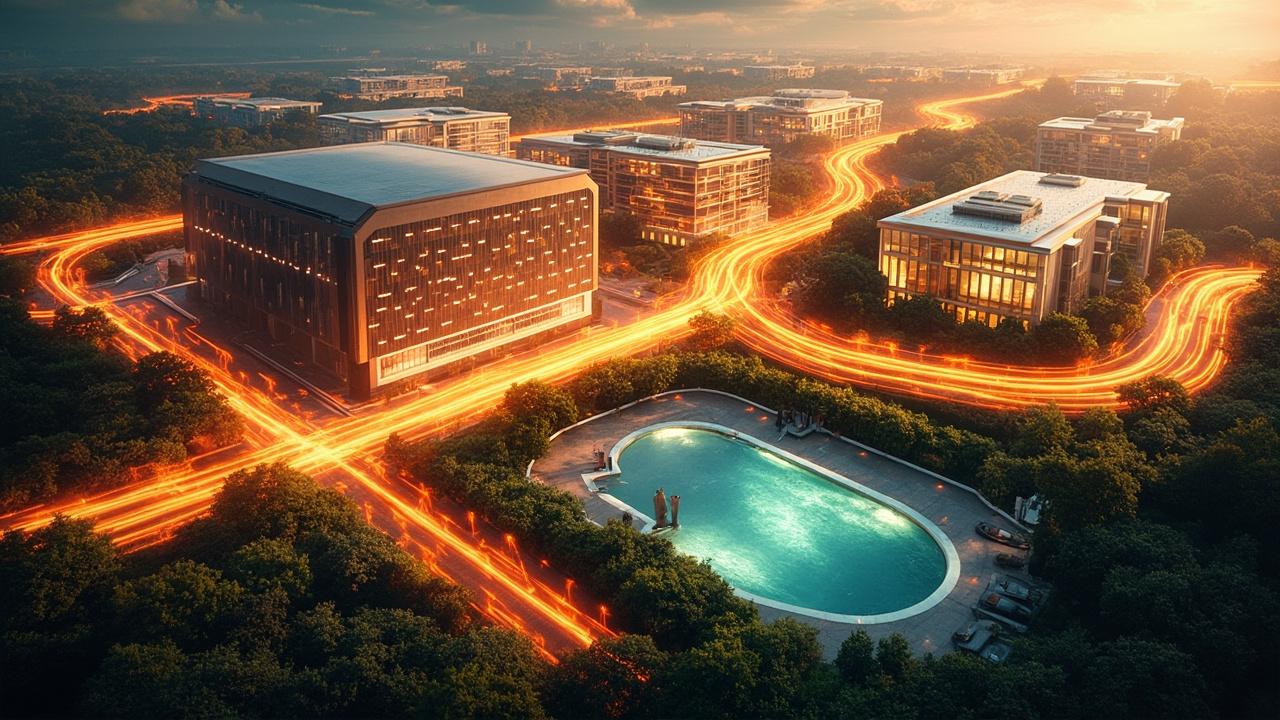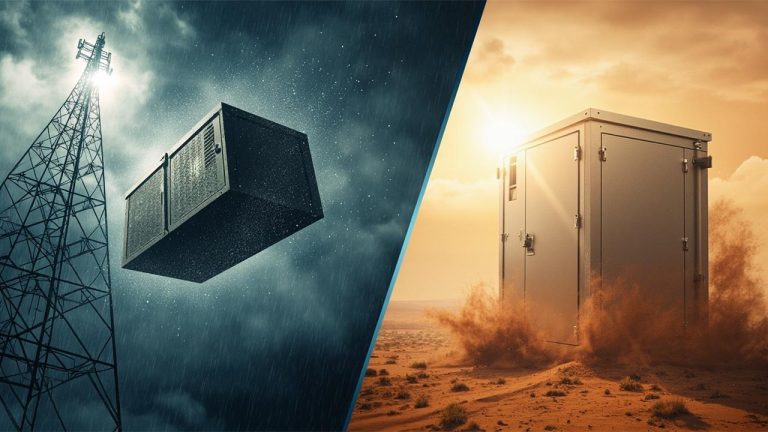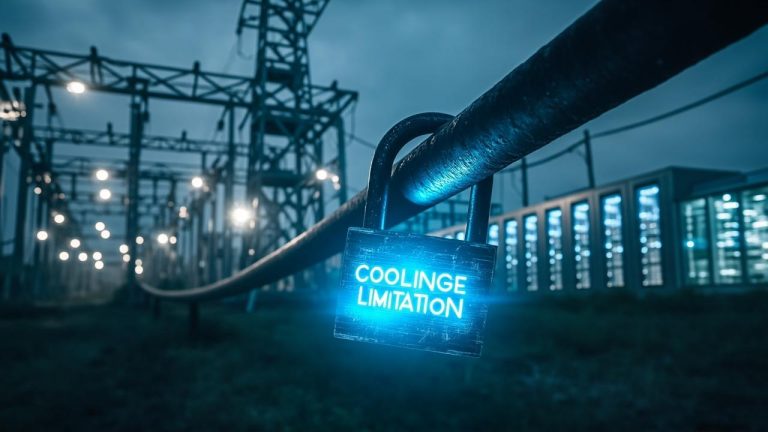Introduction
Heat reuse is key to a greener future. Did you know that data centers consume an estimated 1-3% of the world’s total electricity? More shocking is the fact that a significant portion of this energy is converted into waste heat, which is often simply released into the environment. Imagine if this wasted thermal energy could be captured and repurposed to heat homes, power industries, or even generate electricity for communities.
This seemingly futuristic concept is closer to reality than you might think. Data centers, the backbone of our digital world, are essentially massive heat generators. Instead of viewing this heat as a byproduct to be discarded, we can look at it as a valuable resource waiting to be tapped. By implementing waste heat recovery systems, data centers can transform from energy consumers into energy providers, creating a symbiotic relationship with their surrounding communities.
The potential benefits are far-reaching. Capturing and reusing waste heat from data centers can significantly reduce our reliance on fossil fuels, lower greenhouse gas emissions, and create new economic opportunities. It’s time to shift our perspective and recognize that the waste heat emanating from data centers is not a problem, but a powerful asset. Reusing waste heat from data centers offers a viable and sustainable solution to energy challenges, turning a problem into a powerful asset for communities.
Data Centers
The consequence of this massive energy consumption is the generation of an equally massive amount of heat. For every unit of electricity that powers the servers, a corresponding amount of heat is produced as a byproduct. This heat is typically removed from the data center using air conditioning systems, chillers, or other cooling technologies.
These systems, while effective at maintaining optimal operating temperatures, contribute significantly to the data center’s overall energy footprint. Furthermore, many traditional cooling methods rely on water, which is becoming an increasingly scarce resource in many regions. The environmental impact of simply venting this vast quantity of heat into the atmosphere is substantial, contributing to greenhouse gas emissions and exacerbating the urban heat island effect.
The inefficiency of this process is striking. Data centers essentially pay to generate heat and then pay again to get rid of it. This represents a significant waste of energy and resources. While advances in cooling technologies have improved efficiency to some extent, the fundamental problem remains: a valuable energy source is being discarded.
Instead of viewing waste heat as an unavoidable byproduct, there is growing recognition that it can be a valuable resource. Technologies now exist that can capture and repurpose this heat, transforming a liability into an asset. The key is to implement systems that facilitate heat reuse, providing a sustainable and economically viable alternative to traditional cooling methods.
| Metric | Value |
|---|---|
| Typical Data Center Size | Medium |
| Energy Consumption | Several MW |
| Hyperscale Data Center Energy Consumption | Tens to Hundreds of MW |
Unlocking the Potential
Data centers, often perceived as energy guzzlers, possess an untapped potential: the vast amount of heat they generate. Instead of simply venting this heat into the atmosphere, innovative technologies are emerging to capture and repurpose it, transforming a liability into a valuable asset. These technologies form the cornerstone of unlocking the potential of data center heat reuse.
Capturing and Repurposing Technologies
The process begins with capturing the heat generated by servers and other IT equipment. Traditional cooling systems, like air conditioners and chillers, extract heat from the equipment and transfer it to a cooling medium, typically air or water. Instead of releasing this heated medium into the environment, it can be channeled through heat exchangers.
These devices transfer the heat to another fluid, which can then be transported and utilized for various purposes. More advanced systems can use specialized refrigerants to capture heat at lower temperatures, further enhancing efficiency. The selection of the appropriate technology depends on factors such as the temperature of the waste heat, the distance to potential users, and the desired application.
Potential Applications of Reused Heat
The applications of data center waste heat are diverse and promising. One of the most compelling is district heating. By piping the heated water or other fluid to nearby residential and commercial buildings, data centers can provide a sustainable and cost-effective source of heat for space heating and hot water. This can significantly reduce reliance on fossil fuels and lower energy bills for consumers.
Furthermore, data center heat can be utilized in various industrial processes that require heat, such as manufacturing, food processing, or chemical production. In agriculture, the heat can create controlled environments for greenhouses, extending growing seasons and improving crop yields. Aquaculture facilities can also benefit from the stable and consistent heat source, optimizing conditions for fish farming. Another innovative application involves absorption chillers, which use heat instead of electricity to power cooling systems, creating a more energy-efficient cooling solution.
Generating Electricity
While less common, another application of data center waste heat is electricity generation, employing technologies like the Organic Rankine Cycle (ORC). ORC systems utilize the heat to vaporize an organic fluid with a lower boiling point than water. The vapor then drives a turbine connected to a generator, producing electricity.
While the efficiency of ORC systems may be lower than traditional power plants, they offer a valuable way to recover energy from low-grade heat sources, turning what was once a waste product into a source of clean energy. As technology advances, ORC systems become more efficient and economically viable, further expanding the potential for data centers to contribute to a sustainable energy future.
Real-World Examples
Several innovative data centers are moving beyond traditional cooling methods and embracing waste heat reuse, proving that the concept is not just theoretical but practically achievable and beneficial. These pioneering facilities demonstrate various approaches to capturing and repurposing excess heat, offering valuable lessons for the industry and communities alike.
One prominent example is Google’s data center in Hamina, Finland. This facility utilizes seawater cooling, a highly efficient method that significantly reduces energy consumption. However, Google is also exploring the potential to integrate its cooling system with the local district heating network.

This would allow the excess heat generated by the data center to be used to warm homes and businesses in the surrounding area, reducing reliance on traditional heating sources and lowering carbon emissions. The project exemplifies how even advanced cooling systems can be further optimized for heat reuse, maximizing energy efficiency and benefiting the community.
- Example 1: Qarnot Computing: Uses server heat for residential heating.
- Example 2: Interxion (Marseille): Integrated with a district heating network.
- Example 3: Telehouse North Two (London): Provides heat to a local swimming pool.
Beyond Europe, other data centers are finding innovative ways to utilize their waste heat. In some instances, data centers are partnering with agricultural operations to provide heat for greenhouses, extending growing seasons and reducing the energy costs associated with heating these controlled environments. Other facilities are exploring the use of absorption chillers, which use heat to power cooling systems, effectively creating a closed-loop system that minimizes energy waste.
These diverse examples highlight the flexibility of heat reuse and its potential to be adapted to various local needs and resources. Through strategic partnerships and innovative engineering, data centers can transform from energy consumers into valuable contributors to a sustainable energy ecosystem and implement effective heat reuse strategies.
The Benefits Beyond Energy
The environmental advantages of embracing data center heat reuse are substantial and far-reaching. By capturing and repurposing the thermal energy generated by these facilities, we can significantly reduce greenhouse gas emissions. Traditional power plants, often fueled by fossil fuels, contribute heavily to air pollution and climate change.
However, when data centers channel their waste heat into productive applications, the demand for conventionally generated energy diminishes, thereby curbing our reliance on polluting sources. Furthermore, the decreased dependence on fossil fuels leads to improved air quality, particularly in urban areas, resulting in healthier communities and ecosystems.
The economic incentives for adopting data center heat recovery systems are equally compelling. Data centers themselves can experience considerable reductions in their operational costs by offsetting the need for extensive cooling infrastructure. The savings can then be reinvested in further innovation or passed on to consumers. For communities that tap into this energy source, the economic benefits extend to lower heating and cooling bills for homes and businesses.
Moreover, the development and implementation of waste heat reuse projects spur new business opportunities in areas such as engineering, construction, and energy management. The creation of these green jobs stimulates local economies and contributes to a more sustainable workforce. Areas near data centers may also experience an increase in property values as access to affordable heating and cooling becomes a selling point for potential residents and businesses.
Beyond the tangible economic and environmental gains, utilizing data center waste heat yields significant social advantages. These projects can foster enhanced community resilience by providing a reliable and locally sourced energy supply, making communities less vulnerable to disruptions in traditional energy infrastructure.
Furthermore, data centers that actively participate in waste heat reuse initiatives can enhance their public image, demonstrating a commitment to sustainability and corporate social responsibility. The potential of data center waste heat to reduce the urban heat island effect is another considerable social benefit.
Urban areas tend to be significantly warmer than surrounding rural areas due to the concentration of buildings, pavement, and human activities. Effective capture and distribution of data center heat can contribute to lowering overall temperatures, resulting in more comfortable and livable urban environments. Consider the following social benefits:
- Improved air quality leading to better public health
- Increased property values in areas served by data center heating
- Job creation in the green energy sector
- Enhanced community resilience through distributed energy resources
Overcoming the Challenges
There are significant hurdles standing in the way of widespread adoption of data center heat reuse, preventing it from becoming the norm. While the potential benefits are clear, several challenges must be addressed before this sustainable practice can truly take off. These challenges span technical, economic, and logistical domains, requiring a multi-faceted approach to overcome them.
Technical Roadblocks
One of the most significant technical challenges is retrofitting existing data centers for heat recovery. Many older facilities were not designed with heat reuse in mind, making it difficult and expensive to integrate the necessary infrastructure. This can involve significant modifications to cooling systems, the installation of heat exchangers, and the implementation of new piping to transport the recovered heat. The distances between data centers and potential heat consumers can also be a barrier.
Heat losses during transport can reduce the efficiency of the system, making it economically unviable in some cases. Efficient insulation and optimized piping networks are essential to minimize these losses, especially over longer distances. Additionally, ensuring a consistent and reliable heat supply to match the fluctuating demands of consumers is crucial for the successful implementation of these systems. This requires sophisticated control systems and potentially thermal storage solutions to buffer the supply and demand mismatch.
Economic Considerations
The initial investment costs associated with implementing heat recovery systems can be substantial, often acting as a deterrent for data center operators. While the long-term operational cost savings can be significant, the upfront capital expenditure can be a major hurdle, especially for smaller data centers or those with limited budgets.
Regulatory barriers and a lack of clear incentives also play a role. In many jurisdictions, regulations surrounding heat reuse are either non-existent or unclear, creating uncertainty and discouraging investment.
Furthermore, the absence of financial incentives, such as tax breaks or subsidies, makes it more difficult for data centers to justify the initial investment. Demonstrating a clear return on investment (ROI) is vital.
The economic viability of heat reuse projects depends on factors such as the price of alternative energy sources, the demand for heat in the surrounding area, and the efficiency of the heat recovery system. A comprehensive cost-benefit analysis is essential to assess the feasibility of each project.
Logistical and Perception Issues
Matching the supply of waste heat with the demand for heat can be a complex logistical challenge. Data centers typically operate 24/7, generating a relatively consistent stream of heat. However, the demand for heat in surrounding communities may fluctuate depending on the season, time of day, and other factors.
Coordinating with local stakeholders, such as municipalities, businesses, and residents, is essential to ensure that the heat supply meets the demand effectively. This requires open communication, collaboration, and a willingness to adapt to the needs of the community.
Finally, public perception can also be a barrier to adoption. Some people may be concerned about the safety and reliability of heat reuse systems, or they may simply be resistant to change. Addressing these concerns through education and outreach is crucial to building public support for these projects. Successfully navigating these hurdles requires a collaborative effort between data center operators, policymakers, and communities to unlock the full potential of heat reuse.

The Future Is Hot (In a Good Way)
The future of data center waste heat recovery is bright, fueled by ongoing advancements in technology and increasing policy support. Innovations are continually emerging, aimed at improving the efficiency and economic viability of heat reuse systems. For instance, advanced heat exchangers are being developed to maximize heat transfer and minimize energy losses during the recovery process.
These technologies often incorporate new materials and designs that can withstand the demanding conditions within data centers, such as high temperatures and corrosive environments. Furthermore, smart grids and energy management systems are becoming more sophisticated, allowing for better integration of waste heat into existing energy networks. This includes optimizing heat distribution based on real-time demand and grid conditions, ensuring that the recovered heat is utilized effectively.
Government policies and incentives play a crucial role in accelerating the adoption of data center heat reuse. Many countries and regions are implementing regulations that encourage or even mandate the recovery of waste heat from industrial facilities, including data centers. Tax credits, grants, and subsidies are also being offered to offset the initial investment costs associated with implementing heat reuse projects.
Furthermore, streamlined permitting processes and clear regulatory frameworks can help to reduce the administrative burden and uncertainty for data center operators looking to implement these systems. Collaborative efforts between governments, industry stakeholders, and research institutions are essential for developing and implementing effective policies that promote sustainable energy practices and encourage the utilization of data center waste heat.
New business models are also emerging to facilitate the implementation of waste heat recovery projects. Energy service companies (ESCOs) are playing an increasingly important role, offering turnkey solutions that include the design, installation, and operation of heat reuse systems. These companies often assume the financial risk and provide performance guarantees, making it easier for data centers to adopt waste heat recovery without significant upfront investment.
Another promising approach is the development of energy hubs, where data centers are strategically co-located with heat consumers such as district heating systems, greenhouses, or industrial facilities. This colocation minimizes the distance over which the heat needs to be transported, reducing energy losses and infrastructure costs. The concept of energy hubs fosters a symbiotic relationship between data centers and their surrounding communities, creating a more sustainable and resilient energy ecosystem.
| Area | Advancements/Support |
|---|---|
| Technology | Advanced heat exchangers, smart grids for heat distribution |
| Policy | Tax credits, grants, streamlined permitting |
| Business Models | Energy Service Companies (ESCOs), energy hubs with co-location |
Conclusion
The potential benefits of capturing and repurposing the thermal energy generated by data centers are simply too significant to ignore. By embracing innovative solutions and fostering collaborative partnerships, we can transform these energy-intensive facilities from environmental burdens into valuable community assets. The path forward requires a multi-faceted approach, encompassing technological advancements, supportive policies, and a willingness from all stakeholders to invest in a more sustainable future.
Ultimately, the vision of data centers as integrated energy providers is within reach. By actively pursuing waste heat recovery projects, we can unlock a wealth of environmental, economic, and social advantages. From reducing carbon footprints and lowering energy costs to creating new jobs and enhancing community resilience, the benefits of data center *heat reuse* are far-reaching. Embracing this paradigm shift will not only contribute to a greener planet but also foster stronger, more sustainable communities.
It’s time for data center operators, policymakers, and communities to come together and actively explore the immense potential of this untapped energy source. Share this article with your network and leave comments to spark further discussion and inspire action. Let’s work together to harness the power of data center waste heat and build a future where technology and sustainability go hand in hand.
Frequently Asked Questions
What are the primary benefits of heat reuse?
The primary benefits of heat reuse are centered around resource efficiency and reduced environmental impact. Reusing heat significantly lowers energy consumption, decreasing the demand for primary fuel sources and diminishing greenhouse gas emissions.
This also translates to cost savings for businesses and industries that implement such systems, as they become less reliant on external energy supplies. Overall, heat reuse promotes sustainability and responsible energy management.
How can waste heat be effectively captured and stored?
Waste heat can be effectively captured and stored through various methods, including heat exchangers, thermal energy storage systems, and heat pumps. Heat exchangers transfer heat from waste streams to usable fluids or processes. Thermal energy storage, such as using water or phase change materials, allows heat to be stored for later use.
Heat pumps can upgrade low-temperature waste heat to higher, more usable temperatures. The choice of method depends on the specific application and heat source.
What are some common industrial applications of heat reuse?
Common industrial applications of heat reuse are prevalent in sectors like manufacturing, power generation, and chemical processing. In manufacturing, waste heat from machinery can preheat materials or provide space heating.
Power plants can use waste heat to generate additional electricity through combined heat and power systems. Chemical plants can recover heat from exothermic reactions to power other processes, enhancing efficiency and reducing overall energy expenditure.
What technologies are used for heat recovery and reuse?
Several technologies are employed for heat recovery and reuse, including heat exchangers, which transfer heat between fluids; waste heat boilers, which generate steam from exhaust gases; and heat pumps, which upgrade low-temperature heat. Organic Rankine Cycle systems can convert low-temperature heat into electricity.
Furthermore, thermal storage systems are vital for storing recovered heat for future use when demand is high or the heat source is intermittent.
What are the economic considerations and ROI of implementing heat reuse systems?
Economic considerations for heat reuse systems involve initial investment costs, operating expenses, and potential cost savings. The Return on Investment (ROI) is influenced by factors such as energy prices, system efficiency, and the amount of waste heat available.
While initial costs can be substantial, long-term operational savings from reduced energy consumption and potential revenue from selling excess heat can lead to a favorable ROI, especially with government incentives and carbon credits.




